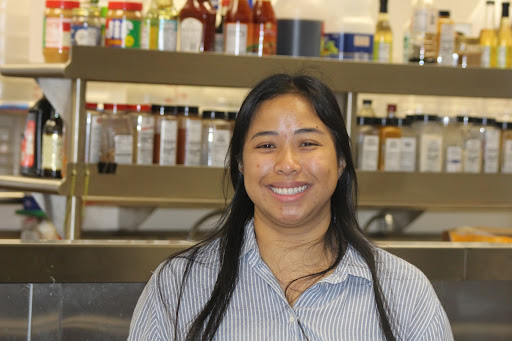
New culinary teacher, Christine Badua, an alumna of Radford High School, was born and raised in the Salt Lake area of Honolulu, Hawaii. As a kid, she always found herself drawn to various types of recipes and cookbooks; there, she was given limitless opportunities to experiment with her creative expression. Eventually, Badua perfected these recipes and cooking techniques through trial and error, which inspired her to further her education in food science and human nutrition at the University of Hawaii at Manoa in 2016 at 26- years-old.
Between the time Badua attended Radford High and now, there have been significant changes. She highlights the technological transition from regular paper and pencil to Chromebooks, laptops, and digital homework.
“Everything was all paper back then. We didn’t have a Google Classroom; we didn’t have to email our teachers; it was always face-to-face interactions. If something happened, you had to just come in and follow up. Badua reflects on her high school days at Radford. Laptops and computers were only used for research, and instead of smart boards, teachers had overheads and projectors to display assignments, lessons, and instructions,” she said.
For her lesson plans and preparations, she’s tasked with arranging assignments and agendas into Google Classroom, composing a food shopping list for labs, calculating the amount of ingredients needed for each class, purchasing the supplies, unloading, and organizing the supplies for labs. While Badua provides students with essential supplies, each student is expected to bring their own resources to class. To clean themselves, their plates, and their utensils before leaving the classroom, students are required to carry their own hand and dish soap. To reduce the risk of cooking-related injuries, open-toed footwear is strictly prohibited. Before proceeding with the cooking process, students are told to review and evaluate cooking demonstrations or recipes and gather their ingredients, tools, and equipment. This promotes greater lab efficiency, prompt completion, and organizational abilities, and reduces the likelihood of errors and mishaps.
In order to ensure the safety of all students, every culinary room is equipped with safety features. Some of those features that can be found in Badua’s room include an eyewash station where you can cleanse your eyes if any chemicals accidentally get into them. Two distinct fire extinguishers—one red and one silver—are accessible to students in an emergency. The red extinguisher acts as an all-purpose fire extinguisher, while the silver extinguisher is specifically made to put out larger grease fires that erupt in kitchens.
“As a precaution to prevent accidents or injuries, students should be expected to demonstrate kitchen etiquette such as saying ‘hot!, behind!, and corner!’ to inform others they are coming through in their pathway to avoid injuries.” Badua explains proper kitchen safety etiquette.
Sometimes, common and simple are boring, so Badua challenges students from time to time by incorporating culturally diverse dishes. Pork adobo, lumpia, kalua pork, butter chicken, and sushi are a few of the more complex cuisines that students must learn. This allows students to explore different worlds through food while simultaneously educating them about foreign countries.
“I advise students that they may or may not try foods we cook in class before. Please be open-minded; try before you judge the food,” she said.
When preparing cuisines from different nations, Badua advised that one should be open-minded and abstain from prejudice. Even if students don’t enjoy the dish, it’s still important to be considerate and conscious of their language when discussing other dishes. Cooking can be a struggle for many. Badua offers struggling students assistance during labs and a step-by-step guide to ensure they feel confident in conducting their food labs. Badua is most excited about working with students in the kitchen and sharing cooking skills they may use for their friends, families, or themselves.

